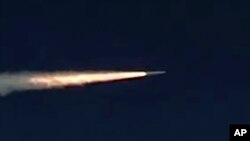The United States and Russia urgently need to revive Cold War-era cooperation to prevent the proliferation of nuclear weapons, according to a new report.
The International Institute for Strategic Studies report, entitled "Once and Future Partners: The United States, Russia and Nuclear Non-Proliferation," uses newly declassified intelligence archives to shed light on the key personal exchanges between the Cold War foes that helped sustain the Non-Proliferation Treaty.
It also highlights a key moment in Cold War cooperation that helped prevent the spread of nuclear weapons to the African continent.
WATCH: Henry Ridgwell's video report
In August 1977, Soviet spy satellites detected preparations for a nuclear weapons test at the Vastrap military base in South Africa's Kalahari desert. Moscow's decision to consult Washington before going public with the discovery indicates the Cold War foes could still work together in non-proliferation matters, says Nicholas Redman of the International Institute for Strategic Studies.
"The Soviet Union did not have diplomatic relations with the apartheid regime. It did, however, have intelligence which suggested that [nuclear] test preparations were underway. The Soviets took the risk of sharing this intelligence with the United States. The United States did have relations with Pretoria, had indeed assisted the civilian nuclear program, but evidently had no interest in allowing South Africa to conduct a nuclear test," Redman said.
Pretoria denied it planned to conduct any nuclear test. However, U.S. intelligence soon confirmed the presence of the test site and helped pressure South Africa into abandoning its plans. The destruction of the Kalahari facility was eventually overseen by inspectors from the U.N. nuclear watchdog the IAEA in 1993.
The collaboration between Cold War foes, led then by U.S. President Jimmy Carter and Soviet General Secretary Leonid Brezhnev, is one of numerous examples of Washington and Moscow working together to prevent the spread of nuclear weapons.
"Personal relations were absolutely key to building not only the non-proliferation treaty, but the entire non-proliferation regime that then grew around it. The fact that there were arms control specialists and scientific specialists in both governments, the fact that they met regularly ... this was actually vital in building the entire regime," Redman added.
The construction of that regime entailed a decade of U.N. talks in Geneva during the 1960s, culminating in the 1970 Non-Proliferation Treaty or NPT, which remains the cornerstone of efforts to prevent the spread of atomic weapons and a testimony to Cold War cooperation.
Increased pressure
But half a century later, the IISS report warns the NPT is under pressure from many sides, just as relations between Moscow and Washington are worse than at any point since the Cuban Missile Crisis in October 1962.
"So there's a need for an investment to rebuild these habits of cooperation because the threats haven't actually gone away. There are still a lot of nuclear weapons that aren't as secure as we would like them to be. There are even more nuclear materials," Redman said.
There are fears of a new arms race, with Russia developing tactical atomic weapons and the United States modernizing its nuclear capabilities.
The 2017 Treaty on the Prohibition of Nuclear Weapons was not signed by any nuclear powers and shows a growing divide between countries with and those without atomic weapons.
"Unless the United States and Russia cooperate, the problem is they could very quickly lose the initiative that they have held up till now in the nuclear proliferation sphere," Redman said.
International image
The report identifies seven lessons that may help to revive non-proliferation cooperation, including "recognition by policymakers on both sides that their countries' international images typically were enhanced when they were seen to cooperate."
The report urges policymakers in both the United States and Russia to learn lessons from Cold War history as the world still faces grave nuclear threats.













